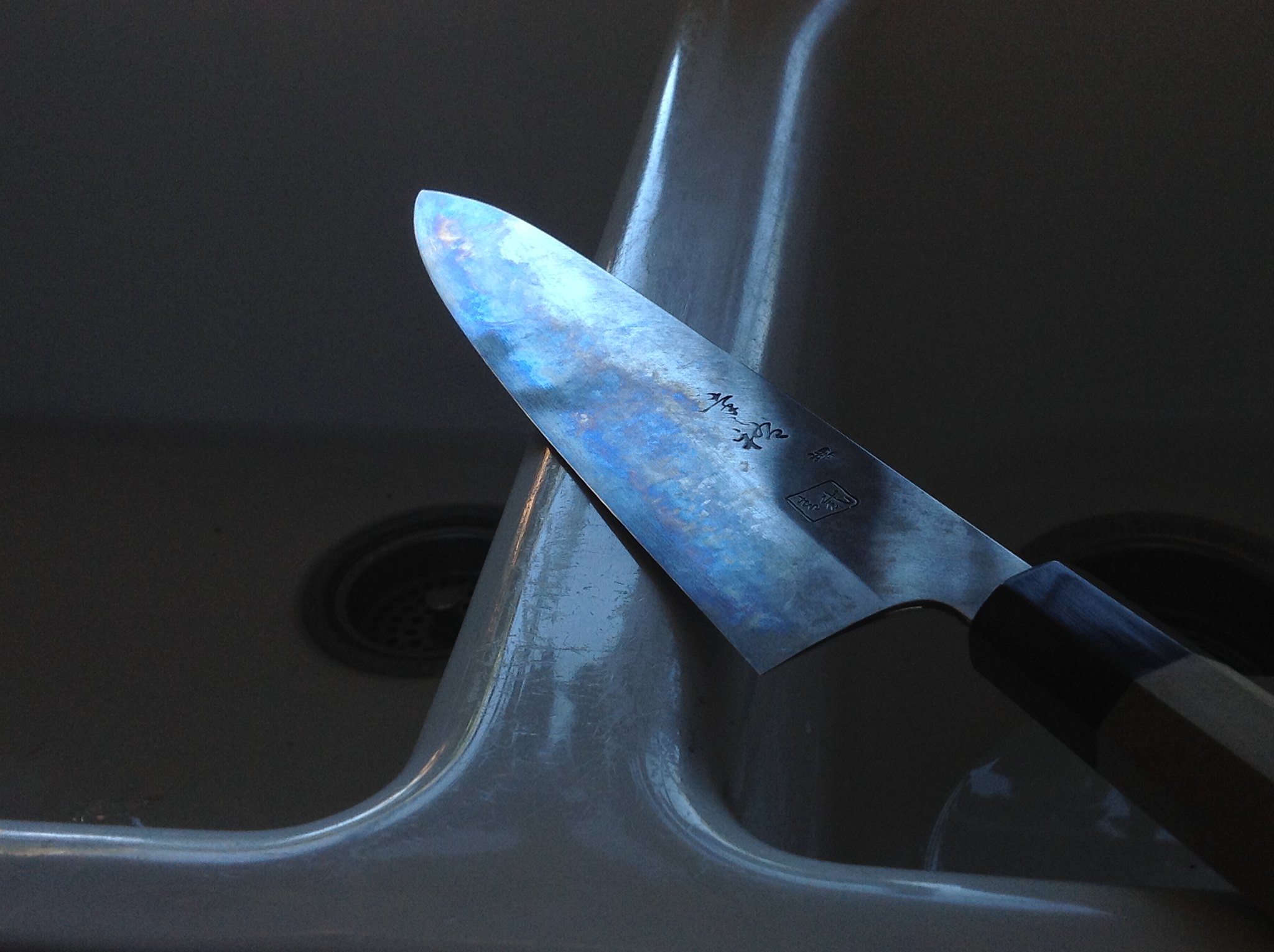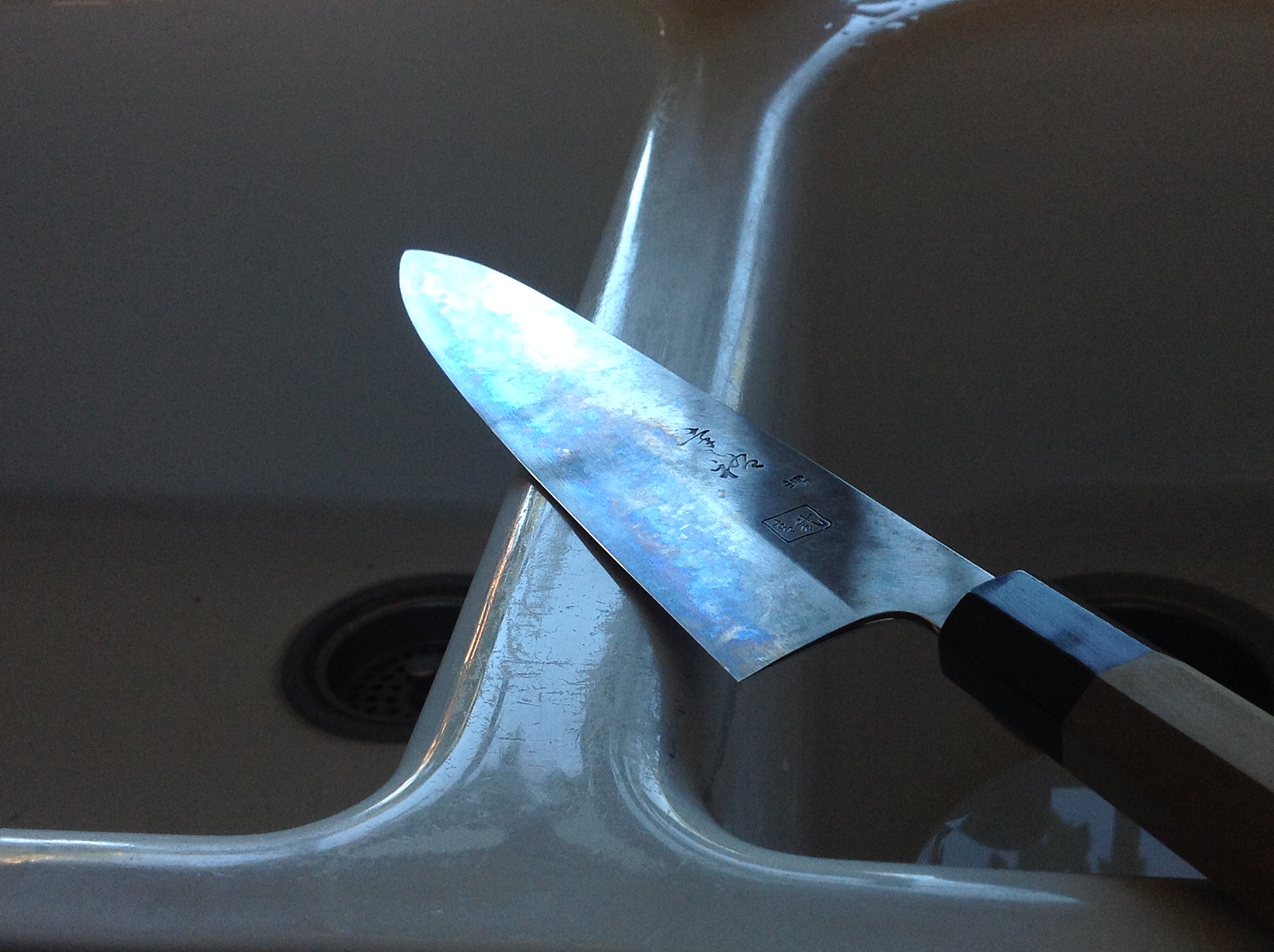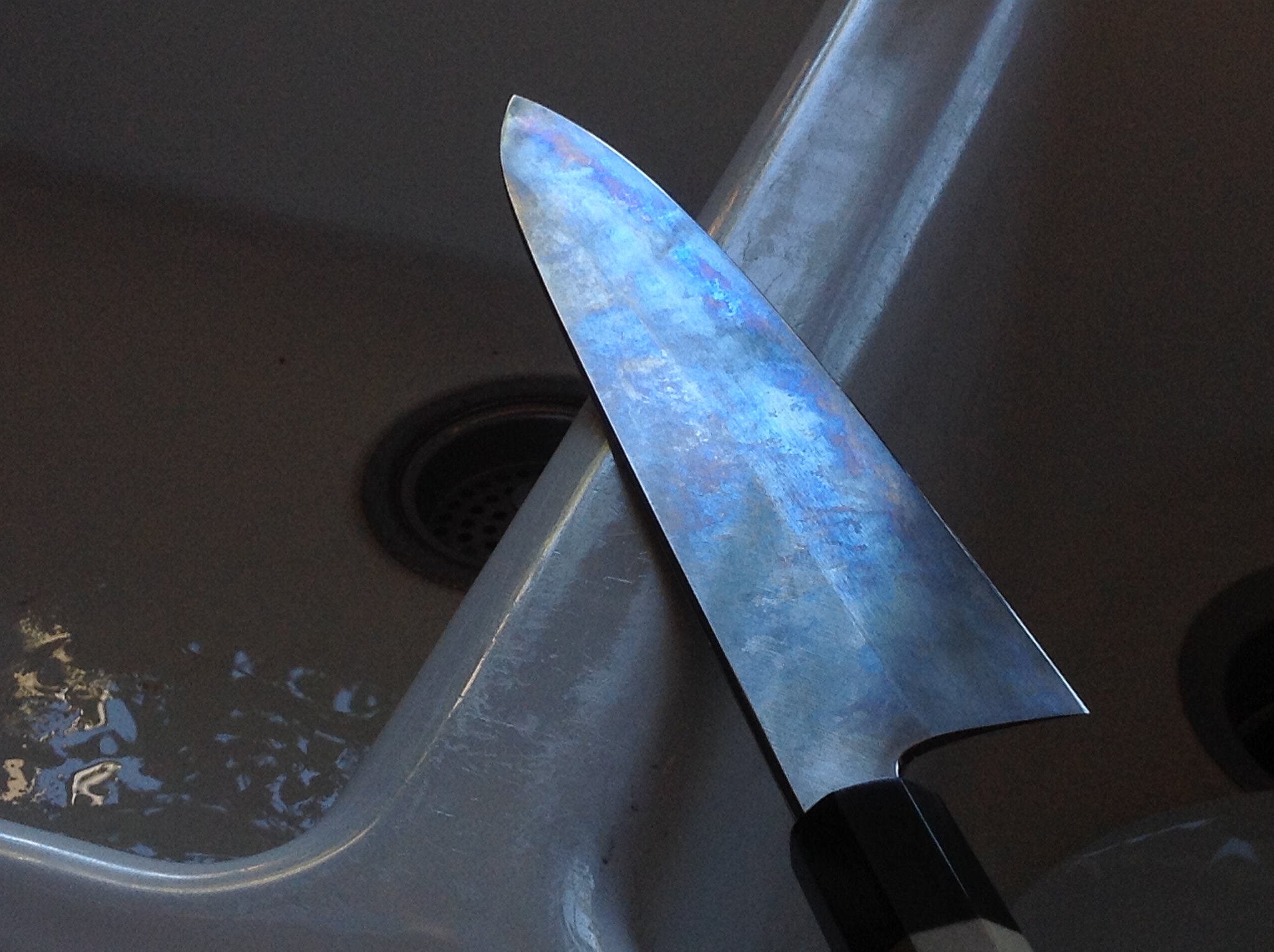You are using an out of date browser. It may not display this or other websites correctly.
You should upgrade or use an alternative browser.
You should upgrade or use an alternative browser.
My favorite color is BLUE!.............A patina thread.
- Thread starter Jim
- Start date

Help Support Kitchen Knife Forums:
This site may earn a commission from merchant affiliate
links, including eBay, Amazon, and others.
- Joined
- May 3, 2011
- Messages
- 9,817
- Reaction score
- 4,534
No need for that. Do it again, degrease before and rinse with very hot water after.Thx i will scrape it off and start from scratch.
chinacats
Senior Member
- Joined
- Mar 20, 2012
- Messages
- 7,123
- Reaction score
- 312
at least until it looks dry...maybe 25-30 minutes...repeat...not sure where, but Lucretia did a wip on a forced patina that was very good and looked pretty cool too.
...or again, just start cutting food and let a natural patina form...so much more fun
...or again, just start cutting food and let a natural patina form...so much more fun
spoiledbroth
Senior Member
- Joined
- May 17, 2015
- Messages
- 1,764
- Reaction score
- 4
I had a lot of success taking off my first failed forced patina with toothpaste and an old toothbrush... the toothpaste is the kind that contains arm&hammer, not sure if it was enough to make much of a difference but it only took about 20min of vigorous scrubbing to remove a fairly dark patina. Now not sure if I should try to build a natural patina or not... it is a very cheap carbon knife, Misono knockoff Masazumi ... 100 usd on closeout. Steel is quite reactive...
Anyone know what the deal is with daikon and baking soda? does this stop patina from forming at all for a short period or just prevent the bad type of rust from forming?
Anyone know what the deal is with daikon and baking soda? does this stop patina from forming at all for a short period or just prevent the bad type of rust from forming?
420layersofdank
Senior Member
- Joined
- Feb 9, 2013
- Messages
- 594
- Reaction score
- 2
Show off 
I've been using this for just under a week at home, got it last Friday from JCK. It's mirror polished Aogami super core clad with mirror polished stainless nickel Damascus. The core has darkened dramatically and depending on the angle and light, the has hints of cobalt blue, grape juice purple, and copper. This is about the best I can do with an iPhone and no special lenses, equipment, settings or modifications:


Wow that picture uploaded terribly, I really should look into photobucket or something similar.
spoiledbroth
Senior Member
- Joined
- May 17, 2015
- Messages
- 1,764
- Reaction score
- 4
wow she's a beaut none the less... That one I'll definitely take off your hands if you ever get tired of it...!  I've been really enjoying the profile on my sukenari (looks about the same as yours).
I've been really enjoying the profile on my sukenari (looks about the same as yours).
420layersofdank
Senior Member
- Joined
- Feb 9, 2013
- Messages
- 594
- Reaction score
- 2
Tjangula, that looks sweet! Love the faux San Mai you did with the sharpy! Lol jk
I did a crop so hopefully it'll show up better:

Thanks for the previous comments too. I like the profile as well, seems pretty flat, I'll have to compare it to my white #1 Honyaki. No sharpie was necessary, it's weird when you look at it in person how the color changes, sometimes it's difficult to even notice the patina and it just looks grey like the cladding
Thanks for the previous comments too. I like the profile as well, seems pretty flat, I'll have to compare it to my white #1 Honyaki. No sharpie was necessary, it's weird when you look at it in person how the color changes, sometimes it's difficult to even notice the patina and it just looks grey like the cladding
- Joined
- May 3, 2011
- Messages
- 9,817
- Reaction score
- 4,534
About the profile: from the last photo it doesn't look that flat at all, from the previous one I would say an average gyuto profile, a bit flatter than the French and much more than the German ones.
SyndicateNova
Well-Known Member
- Joined
- May 29, 2013
- Messages
- 94
- Reaction score
- 1
A few months use with my Kono Fuji Blue #2 240:
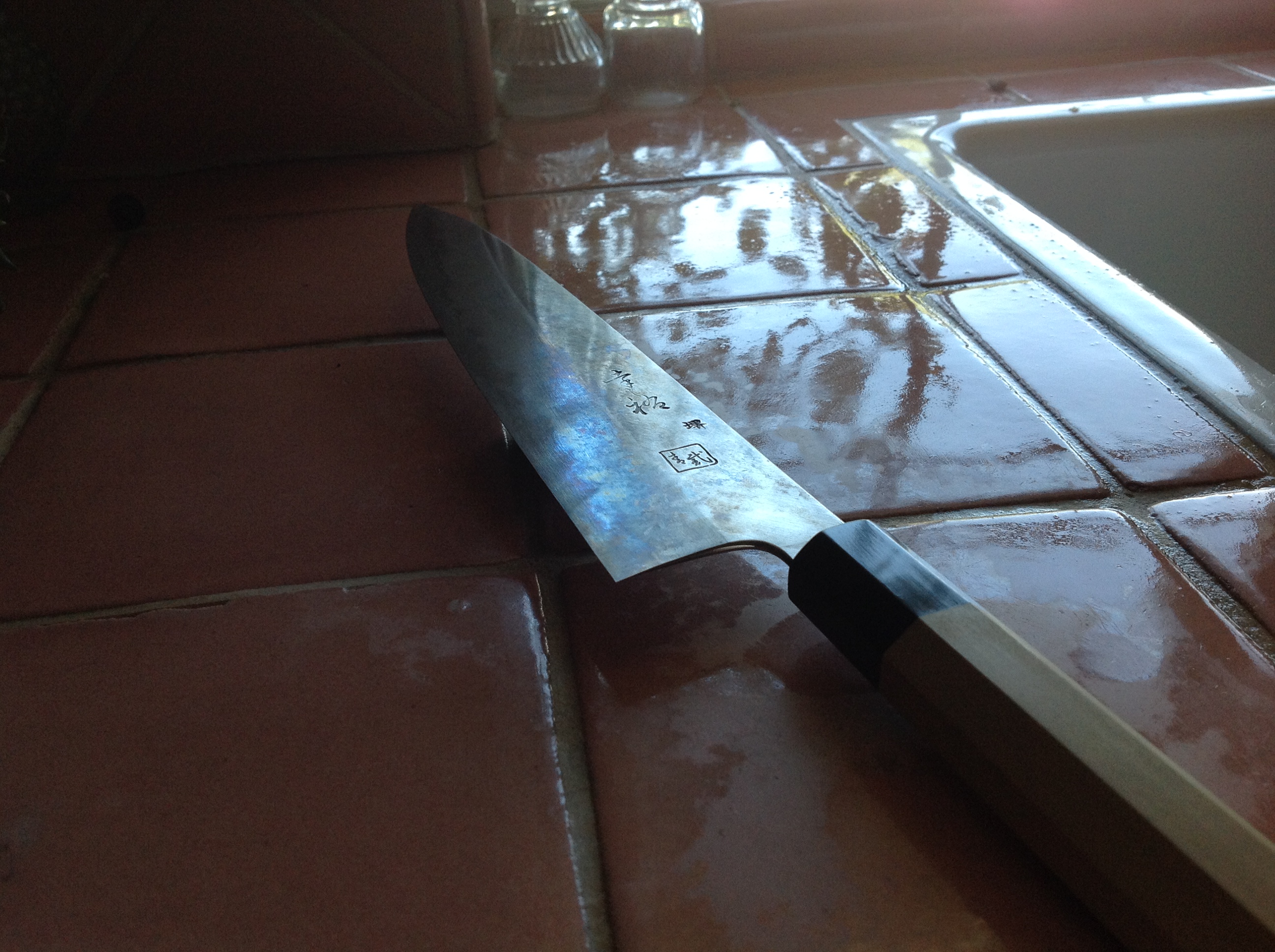
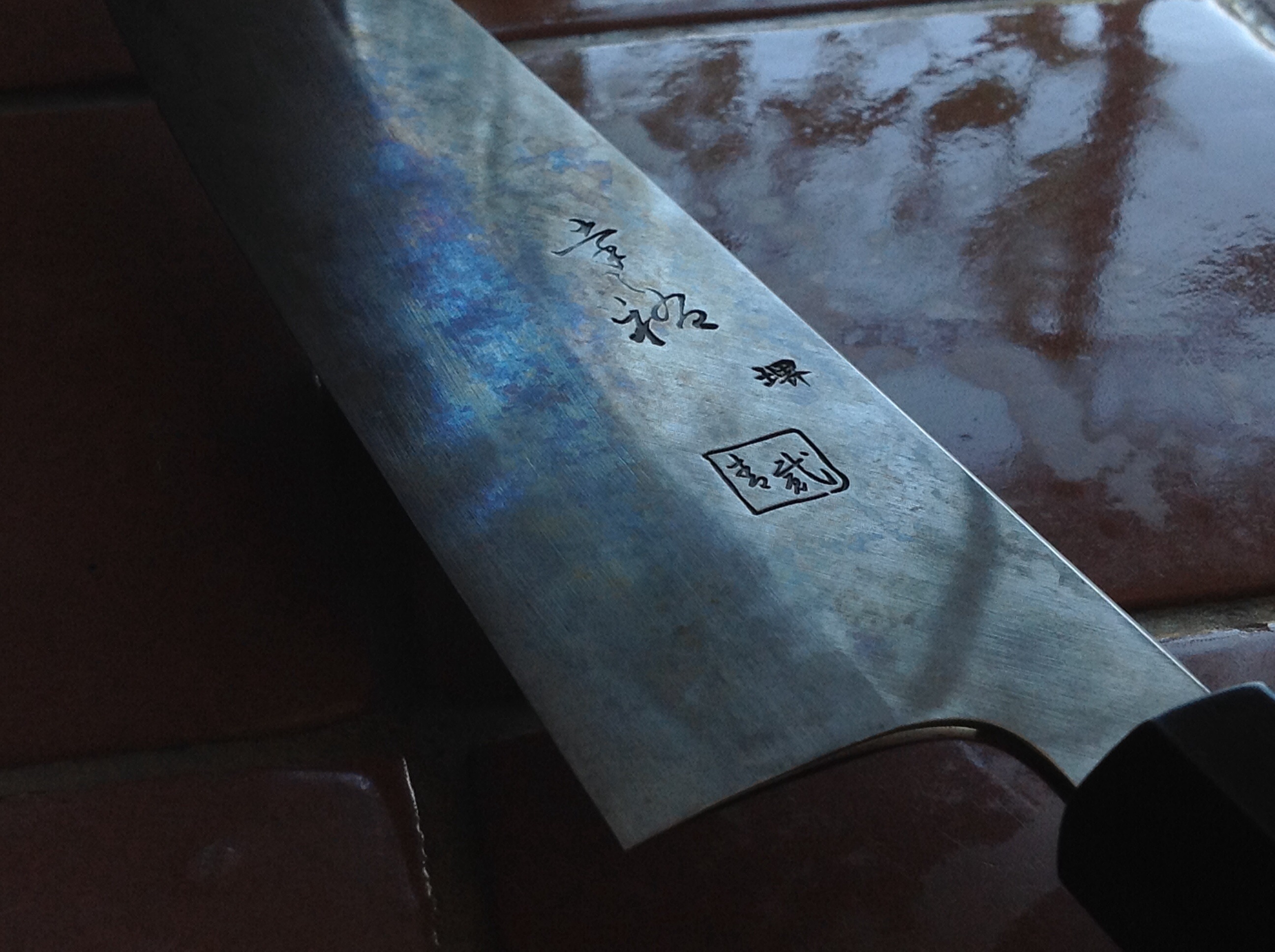
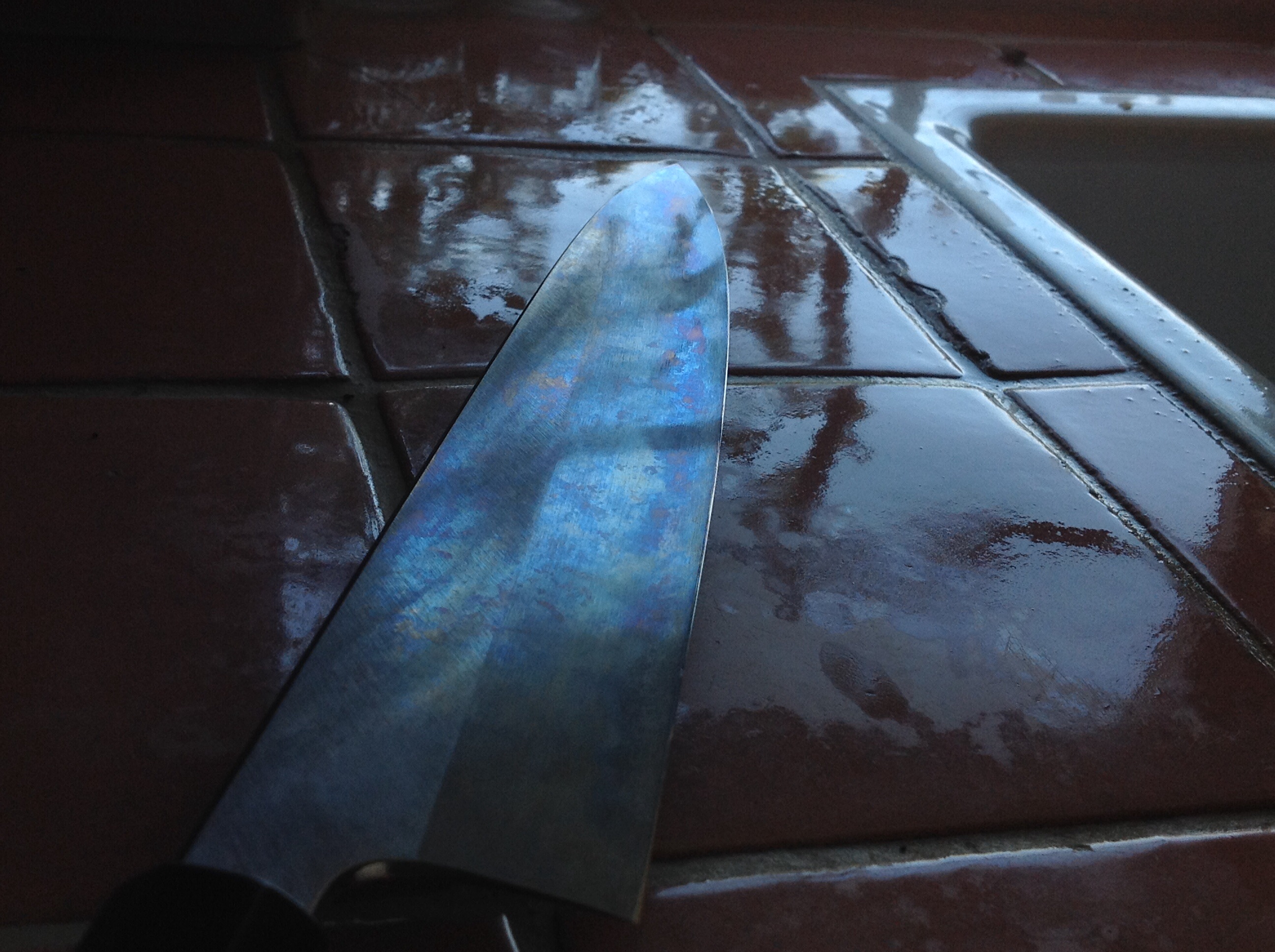
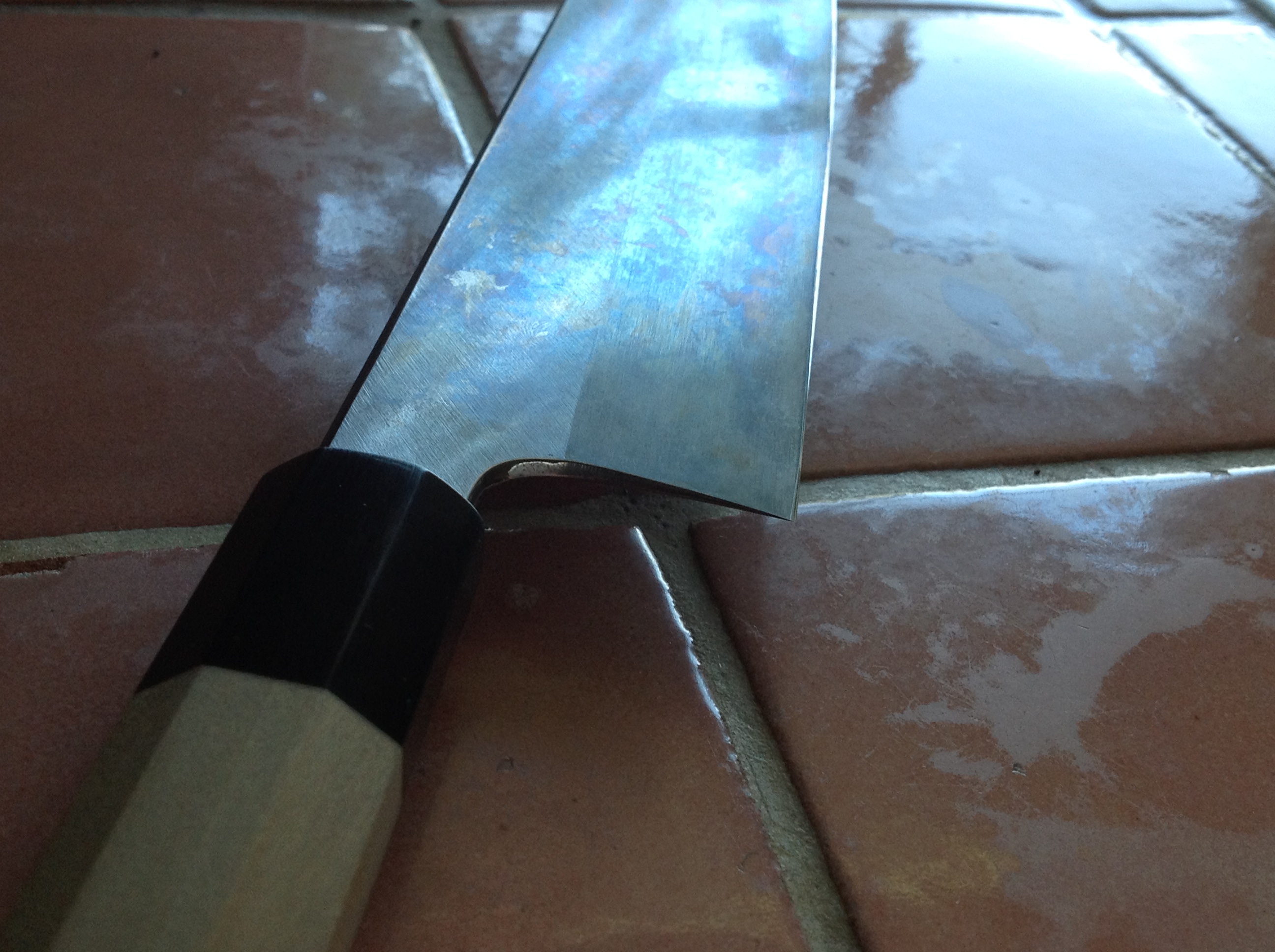
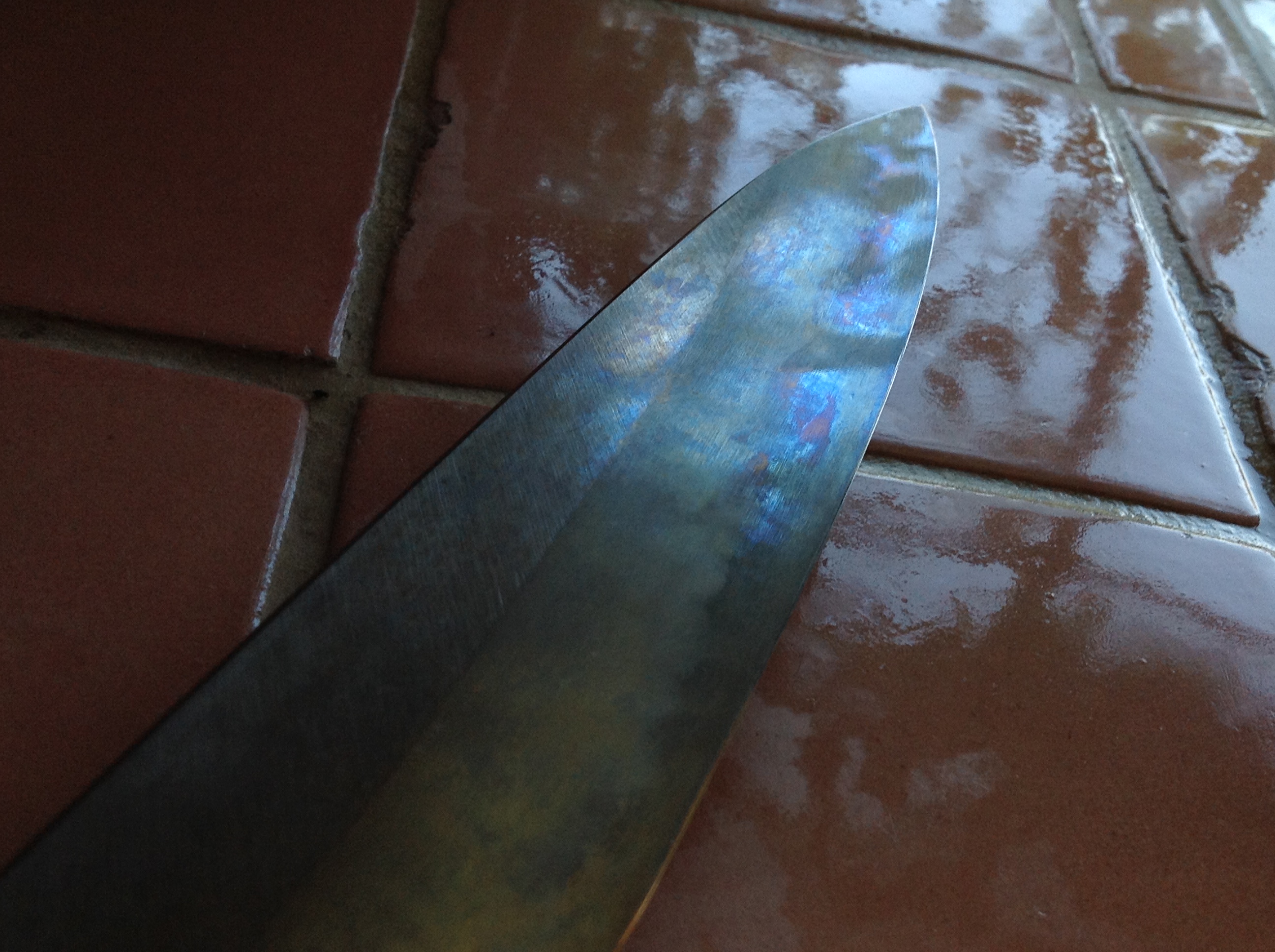
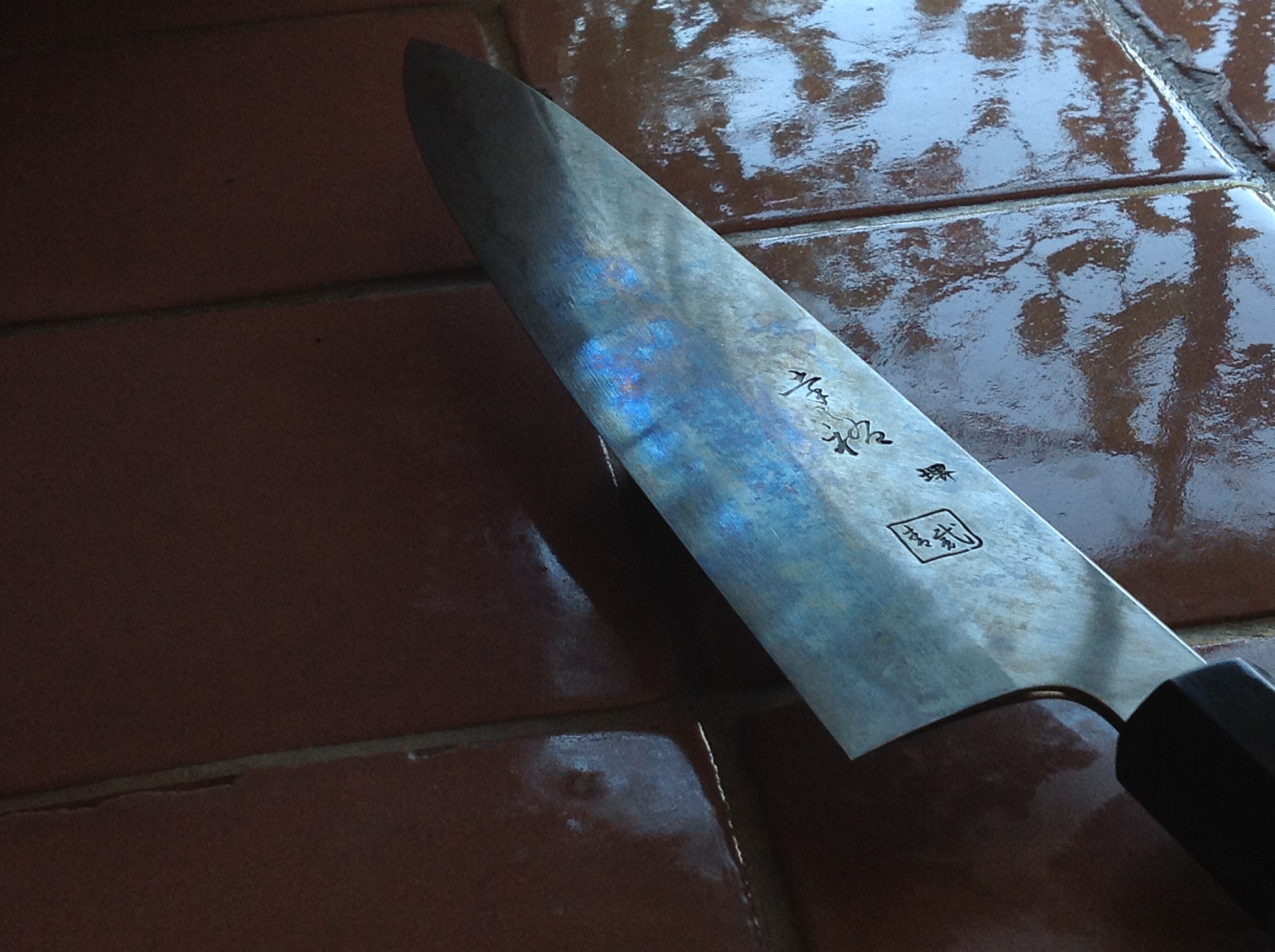






About the profile: from the last photo it doesn't look that flat at all, from the previous one I would say an average gyuto profile, a bit flatter than the French and much more than the German ones.
Just checked, you're correct, quite similar to my 240 Takamura. I must apologize if I confuse the terms, I do find it has some decent flatness though which gives good board contact, much more than this thing:

spoiledbroth
Senior Member
- Joined
- May 17, 2015
- Messages
- 1,764
- Reaction score
- 4
About the profile: from the last photo it doesn't look that flat at all, from the previous one I would say an average gyuto profile, a bit flatter than the French and much more than the German ones.
flatter too than my Hiromotos, also than my CN 210. I quite like it, the Sukenari gyutos seem to have a bit of back bevel then a good third of the 240 (they actually run short I think, traditional measurements) is flat, the belly is quite subtle as well. It is a really good gentle sweep which I think is/was a classic or archetypical gyuto profile. Wasn't a feature of any of my purchases until the Sukenari though and I love it.
Is the sukenari AS cladding reactive? doesn't really look like it.
The AS cladding is a mirror polished stainless nickel Damascus so no reactivity  . One thing which is a bit different from the other two Sukenari Gyutos (Damascus ZDP-189, white #1 Honyaki) is the spine isn't as rounded. It's definitely relieved and polished (no sharpness when you touch), but not radiused as much as the others. I'm going to inquire with Koki what promoted the change but I actually kinda like this, it makes using the spine to scrape the board easier and more effective.
. One thing which is a bit different from the other two Sukenari Gyutos (Damascus ZDP-189, white #1 Honyaki) is the spine isn't as rounded. It's definitely relieved and polished (no sharpness when you touch), but not radiused as much as the others. I'm going to inquire with Koki what promoted the change but I actually kinda like this, it makes using the spine to scrape the board easier and more effective.
From what I remember, the measurent is from the machi to the tip, so they're usually a bit less. It doesn't seem to be a consistency between blade smiths or knife types how they are measured.
From what I remember, the measurent is from the machi to the tip, so they're usually a bit less. It doesn't seem to be a consistency between blade smiths or knife types how they are measured.
spoiledbroth
Senior Member
- Joined
- May 17, 2015
- Messages
- 1,764
- Reaction score
- 4
Wow that makes the knife quite a bit more interesting. The core looks pretty reactive- were you trying to encourage a patina or actually wiping the blade to reduce acidity on the faces of it while cutting? I think it sounds like the spine is eased like on mine... just sort of chamfered. Nicely done though. The guy who sold it to me mirror polished the choil which I don't care for and I think a polished spine might be the same - find it harder to grip when it's super polished and rounded. I also lose sight of the blade on the cutting board all the time if the spine is high polish. :angel2:The AS cladding is a mirror polished stainless nickel Damascus so no reactivity. One thing which is a bit different from the other two Sukenari Gyutos (Damascus ZDP-189, white #1 Honyaki) is the spine isn't as rounded. It's definitely relieved and polished (no sharpness when you touch), but not radiused as much as the others. I'm going to inquire with Koki what promoted the change but I actually kinda like this, it makes using the spine to scrape the board easier and more effective.
From what I remember, the measurent is from the machi to the tip, so they're usually a bit less. It doesn't seem to be a consistency between blade smiths or knife types how they are measured.
sharptools
Well-Known Member
- Joined
- Jul 23, 2015
- Messages
- 256
- Reaction score
- 1
Tjangula which knife exactly is that from JCK?
spoiledbroth
Senior Member
- Joined
- May 17, 2015
- Messages
- 1,764
- Reaction score
- 4
it's in the Sukenari Specials ASD-2 I believe
Tjangula which knife exactly is that from JCK?
it's in the Sukenari Specials ASD-2 I believe
That is correct, I used to have the same knife but with ZDP-189 core in 270mm and was going to get it rehandled, but recently sold it when I saw this one. I really like it so far, the spine is about 3mm according to my callipers and it holds a lot of that going towards the tip but still glides thru onions in the horizontal slices and didn't lift much on the verticals.
http://www.japanesechefsknife.com/SukenariSpecials.html#ASDamascus
Wow that makes the knife quite a bit more interesting. The core looks pretty reactive- were you trying to encourage a patina or actually wiping the blade to reduce acidity on the faces of it while cutting? I think it sounds like the spine is eased like on mine... just sort of chamfered. Nicely done though. The guy who sold it to me mirror polished the choil which I don't care for and I think a polished spine might be the same - find it harder to grip when it's super polished and rounded. I also lose sight of the blade on the cutting board all the time if the spine is high polish. :angel2:
I let it do it's own thing for this one, I started with some raw beef and used it just on proteins for the first few seasons before introducing it to veg. I cut but didn't rinse and wipe immediately as the mirror polish helps prevent reactivity (I remember seeing this in a thread here and it actually makes sense from the science/engineering side of it too).
For my White #1 I went to the veg much sooner and there are actually spots where you can see "radioactive waste green" and magenta, but it's mostly subdued to a frosty grey/white now.
I'd say it's the most subtle chamfer if that, there's a good 2-2.5mm of flat on the top of the spine, but the choil is quite radiused, as with the other two Sukenari knives I've encountered. This was the odd one out with the spine. The San Mai is all the way thru (looks like a 1/3-1/3-1/3) so perhaps they didn't round it as much to reduce the amount of core exposed on the top (still haven't asked Koki)
sharptools
Well-Known Member
- Joined
- Jul 23, 2015
- Messages
- 256
- Reaction score
- 1
My Hiromoto 240mm white #2 from JCK developed this from onions, garlic and carrots. Not very reactive at all but looks cool!
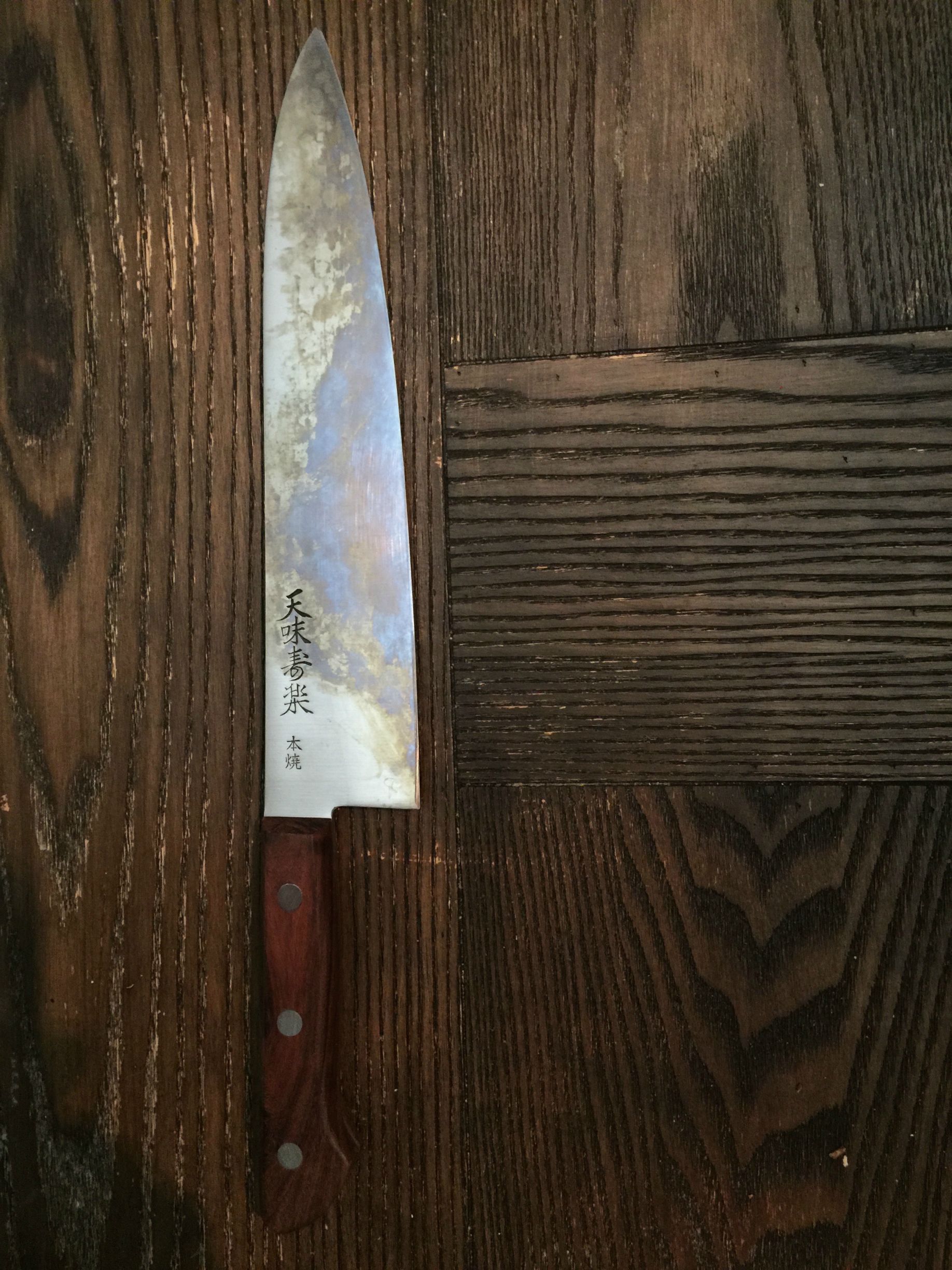

SyndicateNova
Well-Known Member
- Joined
- May 29, 2013
- Messages
- 94
- Reaction score
- 1
- Joined
- Aug 20, 2012
- Messages
- 2,199
- Reaction score
- 961
Not great pics but really interesting to me how the area above the hamon takes a patina at a very different rate. Cutting large heirloom tomatoes for dinner. Mizuno Honyaki.




brooksie967
No more Ashi
Blood patina? On my 330mm yanagi
Nvm cant post attachments?
Nvm cant post attachments?
Last edited:
Blood patina? On my 330mm yanagi
Nvm cant post attachments?
Can you use something like photobucket? You have to be a Site Supporter to upload directly to KKF. Although I can do that I just setup photobucket yesterday and so far so good. I like that the image resolution is better too.







